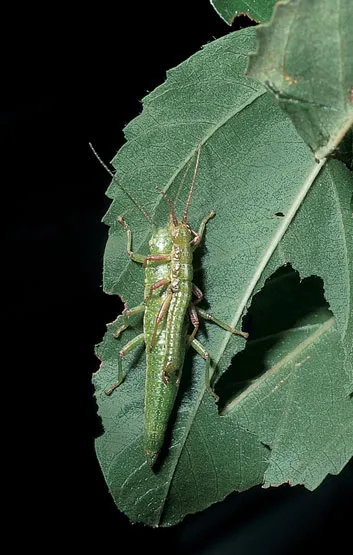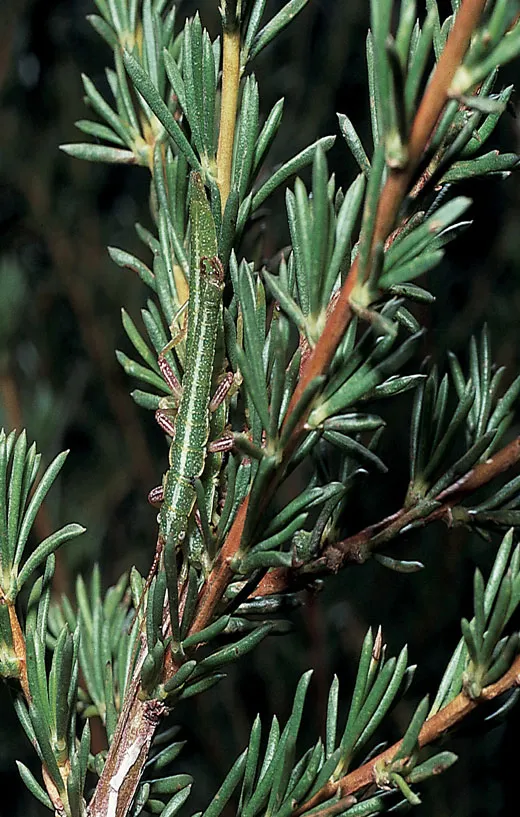Net Gains
A California biologist discovered a new insect species and then caught evolution in the act
What a comfort it is, in this techno-mad age, that a scientist can still do important research in her backyard with a butterfly net.
Cristina Sandoval was an ecology graduate student at the University of California, Santa Barbara when, net in hand, she headed into the chaparral-covered Santa Ynez Mountains near campus in search of a thesis. There, she slipped the net onto various shrub and plant branches, and then shook them to see what fell out. Along with a dusty trove of dried leaves, spiders and bird droppings, she collected an assortment of inch-long insects that looked like beady-eyed twigs—walkingsticks, distant cousins of crickets and cockroaches. In fact, she had discovered a new species of walkingstick, which, in keeping with taxonomic tradition, was named after her, Timema cristinae. "I felt proud," she said of the honor, adding that it gave her a sense of immortality and even made her feel protective of her six-legged namesake.
The achievement might seem quite sufficient for a scientist-in-training, but it was only the beginning. Braving poison oak, brambles, searing heat and rattlesnakes to observe her walkingstick in its scrubby habitat, baiting homemade traps to learn about its predators, and teaming with other scientists to glean its genetic makeup, Sandoval has pursued this unlikely creature for 13 years. She now believes that it offers a rare glimpse of the process that Charles Darwin famously called "the origin of species." The evidence she has gathered suggests that her walkingstick, because it is so intensely preyed upon by lizards and birds, is on the verge of making biology’s biggest leap by splitting into two distinct species—a phenomenon that scientists have long puzzled over but seldom observed directly.
"One of the biggest questions in biology is, how are species formed?" says Sandoval, 41, who got her doctorate in 1993 and is now director of the Coal Oil Point Reserve, a university-affiliated wildlife refuge in Santa Barbara. "It’s just in us to want to figure out what’s going on in nature to create the amazing diversity we see." Like other walkingsticks, the T. cristinae can’t fly, lives only a few months and spends most of its daylight hours standing perfectly, boringly still. It ranges across the West, Sandoval says, and is plumper and has shorter legs than other walkingsticks, and the male’s genitals are distinctive. But the main reason that Sandoval has studied the insect so intensively is its coloration, which comes in two forms and varies according to the type of bush the insect inhabits. Those that favor the ceanothus plant, which has yellowish green oval leaves, are themselves plain yellowish green; they like to rest in the middle of a ceanothus leaf. By contrast, a T. cristinae partial to the chamise bush, which has dark green, needlelike leaves, bears a stripe on its back and straddles a leaf. In either case, the coloration renders the insect almost invisible to predators such as blue jays and lizards, as Sandoval found in field tests. When she placed striped or plain insects on a branch from their preferred bush, far fewer were gobbled up compared with those she put on branches of the "wrong" bush.
That a walkingstick is living camouflage is no surprise; after all, grade-school kids study the creature as one of nature’s more blatant examples of adaptation. But Sandoval has taken the phenomenon to a new level. According to the standard view of adaptation, an individual with a defensive edge is more likely than a run-of-the-mill specimen to survive in a competitive bird-eat-bug world and pass on its genes to the next generation. But how does a variety distinguished only by a defense mechanism evolve into a new species that no longer mates with members of the species from which it sprang?
Part of the answer may reside in T. cristinae’s mating habits. A striped or plain variety tends to mate with its own kind, Sandoval and coworkers found, even though the insects have poor eyesight. The preference could be based on smell, she says, or a breakdown in the courtship ritual. When a male walkingstick wants sex, he crouches on top of the female and tickles her antennae with his own, while stroking her abdomen with his feet. If interested, she’ll mate; if not, she’ll push him away. "Maybe males of different varieties no longer have the right equipment," Sandoval says. "Maybe they don’t do the right tickle."
Whatever cues the insects use, what’s important is that, somehow, the genes that influence mating preferences are passed along with the genes that determine whether the walkingstick is striped or plain. Then predators brutishly reinforce the T. cristinae’s mating choices: offspring that are neither striped nor plain probably don’t hide well and are easy pickings for lizards and birds. Offspring that do hide well survive, mate with their own kind, and so on. If, over time, instances of successful interbreeding between striped and plain varieties were to sink to close to zero, then two species would exist instead of one.
Since Darwin, biologists have generally believed that new species form in nature after some singular chance event. But Sandoval and coworkers recently reported evidence quite to the contrary, showing that striped and plain varieties were popping up all over the hills. Working with molecular biologists at Simon Fraser University in British Columbia, she sampled DNA from several populations of striped and plain walkingsticks on a Santa Ynez slope. She found that a striped and a plain walkingstick from the same bush are more closely related to each other than they are to walkingsticks of similar appearance that live several bushes away. Plain green and striped walkingsticks are continuously being born on, say, the flat-leafed bush. But plain green cristinae end up predominating because predators wipe out most of the striped individuals.
That’s big news to evolutionary biologists, who have long believed that two groups from one species would have to be separated by vast barriers of geography and time—an ocean or mountain range, for example, and perhaps thousands of years—before they would evolve to the point where they would not or could not interbreed. The finding that the two visually distinct varieties of T. cristinae arose not once, but multiple times in bush after bush, is a strong sign that no geographic barrier or imponderable period of time is necessary for speciation.
Dolph Schluter, an evolutionary biologist at the University of British Columbia in Vancouver, has found similar results in his studies of stickleback fish. He says the walkingstick findings are "extremely cool" because they combine DNA technology with old-fashioned fieldwork to reveal the inner workings of evolution, which are usually too slow to observe.
Sandoval says there’s no substitute for beating the bushes. "To be a good naturalist you have to go out in the field with your eyes wide open," she says. "You have to pay attention to develop intuition. Analytic skills are important, and so is luck. But intuition is crucial, so that you’re always ready to pursue what luck turns up."

